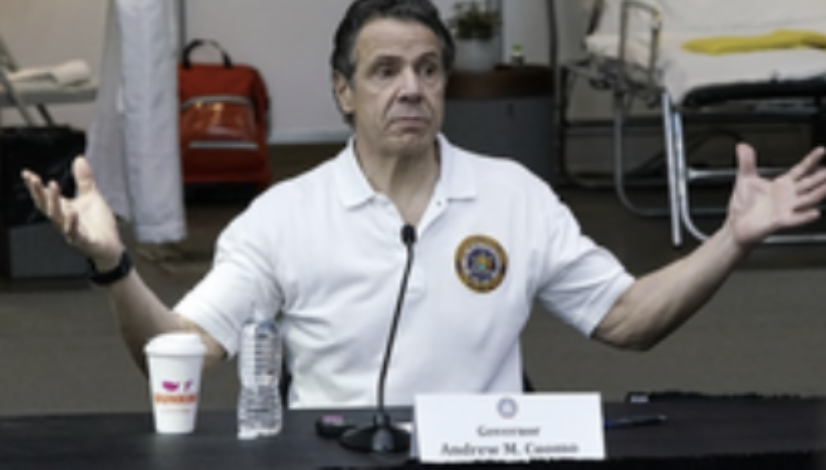Cuomo’s brush with stardom will fade — and rightly so

Governor Andrew Cuomo lost his cool at his press briefing recently when asked by a reporter why New York should not begin to lift its restraints on some businesses.
“You want a job? Go to work at an essential business,” the governor answered snippily, scoffing at the notion that some people might like to go back to work.
It was an unusual crack in Cuomo’s façade. Perhaps the governor can see the future, a future in which he no longer commands the attention of the nation, and in which his brief brush with national stardom fades.
For sure, one of the most surprising outcroppings of the coronavirus has been Cuomo’s surging popularity. Disasters can create heroes, but Cuomo hardly qualifies, given that his misjudgments and botched response helped New York become the epicenter of the pandemic.
Even the New York Timesacknowledges, “initial efforts by New York officials to stem the outbreak were hampered by their own confused guidance, unheeded warnings, delayed decisions and political infighting…”
In fact, Cuomo and New York City Mayor Bill de Blasio were both guilty of expressing unjustifiable confidence in their ability to control the virus early on, waiting too long to impose social distancing and other restrictions and not being prepared for the rapid spread of the disease.
In short, exactly the same missteps that they and the liberal media have laid at President Trump’s door. And yet, the media continue to hammer the White House, while they have allowed Cuomo, especially, to become a pandemic matinee idol, spending hours on air rattling off statistics on deaths and infections, and engaging in spunky repartee with his broadcaster brother. Go figure.
Cuomo’s TV persona has given him his first shot at pursuing national office. There is ongoing chatter that presumptive nominee Joe Biden might pick him as his running mate, despite earlier vows to choose a woman, and even rumors that Democrats might somehow toss the befuddled former veepoverboard and substitute Cuomo at the last minute.
A poll, conducted earlier this month by Rasmussen, found Democrats nearly split, with 46 percent favoring Biden and 45 percent going for Cuomo. In that survey, the New Yorker’s approval rating was 53 percent; in 2018, it was only 29 percent.
That’s quite a turnaround, and it comes, we are told, from Cuomo’s “response” to the pandemic. A response, it should be noted, that includes overseeing the deaths of more than 14,000 people, 37 percent of the national coronavirus death toll. According to the Times, “Even after adjusting for population size, the state still has the highest fatality rate for coronavirus in the nation.”
Why such a tragic toll? Certainly part of the problem stems from New York City’s population density, inadequate infrastructure and high levels of poverty.
But New York State, even excluding the city, has been ravaged as few others. Part of the blame for the disproportionate devastation is because Cuomo (and de Blasio) moved too slowly to impose social distancing and shut down the state.
In February, a woman who had traveled to Iran arrived at JFK airport, and soon tested positive for the virus. Cuomo and de Blasio, in a joint press gathering, vowed to track the woman’s every contact, but never did.
Even as a “hot spot” developed in New Rochelle, instigated by a person working in Manhattan, de Blasio failed to research the worker’s city contacts, and continued to urge people to go out and enjoy themselves.
On March 2, even as more cases emerged, Cuomo and de Blasio radiated confidence that New York had the situation under control. “We have been ahead of this from day one,” Cuomo claimed. “From day one. It was a big break when the federal government allowed us to do our own testing because now we are actually in control of the systems ourselves. And as New Yorkers we like control.”
It was not long before Cuomo was blaming the federal government for inadequate supplies of tests.
At the March briefing, the governor further assured his constituents, “When you’re saying, what happened in other countries versus what happened here, we don’t even think it’s going to be as bad as it was in other countries.”
Dr. Thomas R. Frieden, the former head of the Centers for Disease Control and Prevention, told the Times, “If the state and city had adopted widespread social-distancing measures a week or two earlier, including closing schools, stores and restaurants, then the estimated death toll from the outbreak might have been reduced by 50 to 80 percent.”
But they didn’t.
Cuomo also made some unimaginable goofs, like allowing infected patients to enter nursing homes, the most vulnerable of accommodations.
New York’s infections and deaths have begun to decline. That is good news for the state, but bad news for an ambitious governor who is enjoying the spotlight. Cuomo recently made headlines by meeting with President Trump to press for more aid, and he has commanded the local news cycle by issuing seemingly whimsical edicts opening and closing golf courses and marinas, sparring endlessly with de Blasio and complaining that he is not getting enough help from the feds.
But his moment may be passing, and rightly so. Cuomo’s stardust will quickly dissolve under closer examination of his record as governor. Some of his closest advisers and donors have ended up in jail. He has wasted billions on economic boondoggles like massive solar panel factories while denying the state significant resources by banning fracking. More recently, according to those who know, he has simply checked out.
Meanwhile, New York is notable for having the highest taxes in the nation, leading the country in population losses and being one of the most unfriendly states (number 47) to small businesses.
The governor is no mere bystander to these unhappy trends. He is also no mere bystander to the outsized number of COVID-19 deaths in New York State.
Published on The Hill



